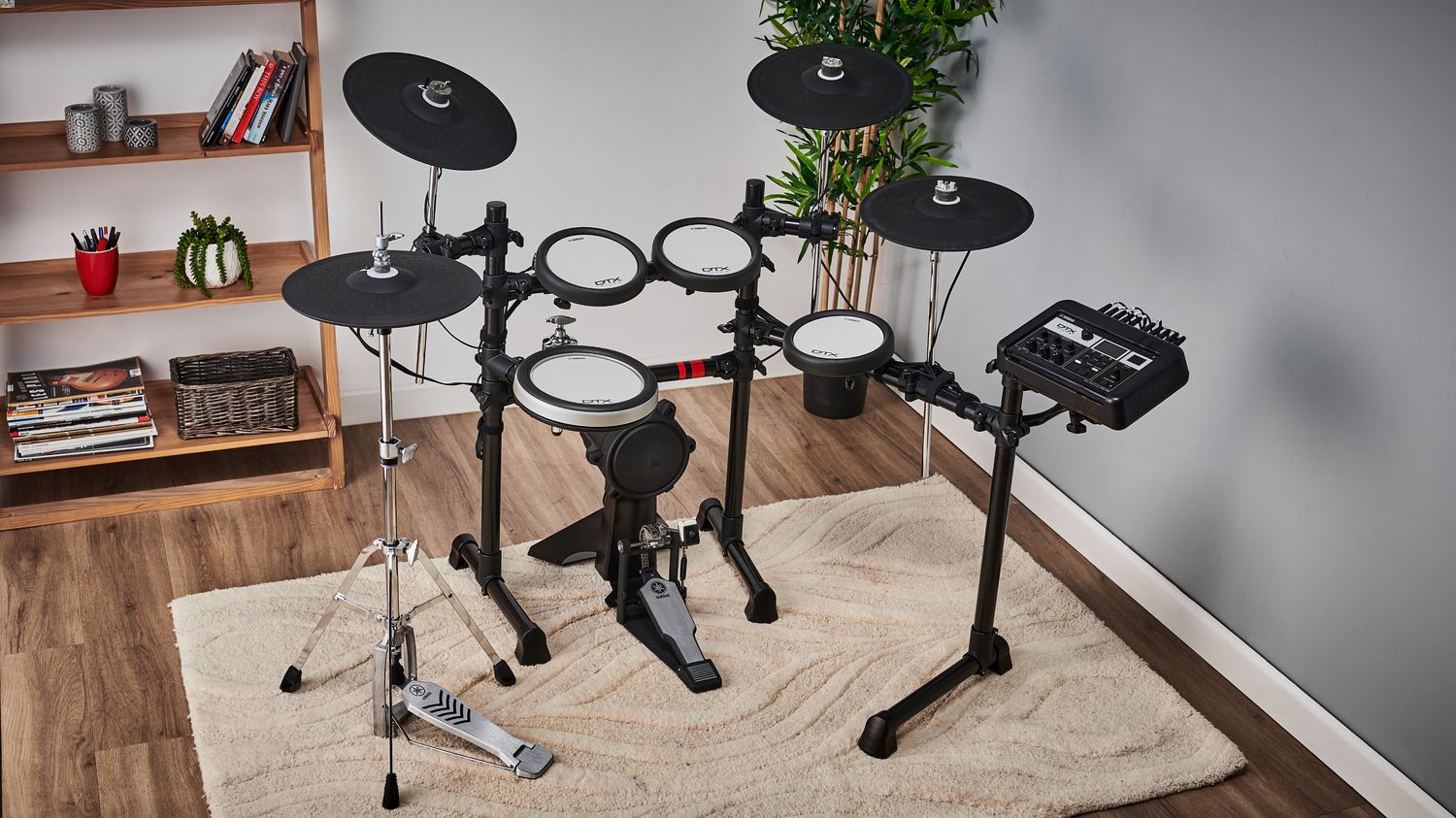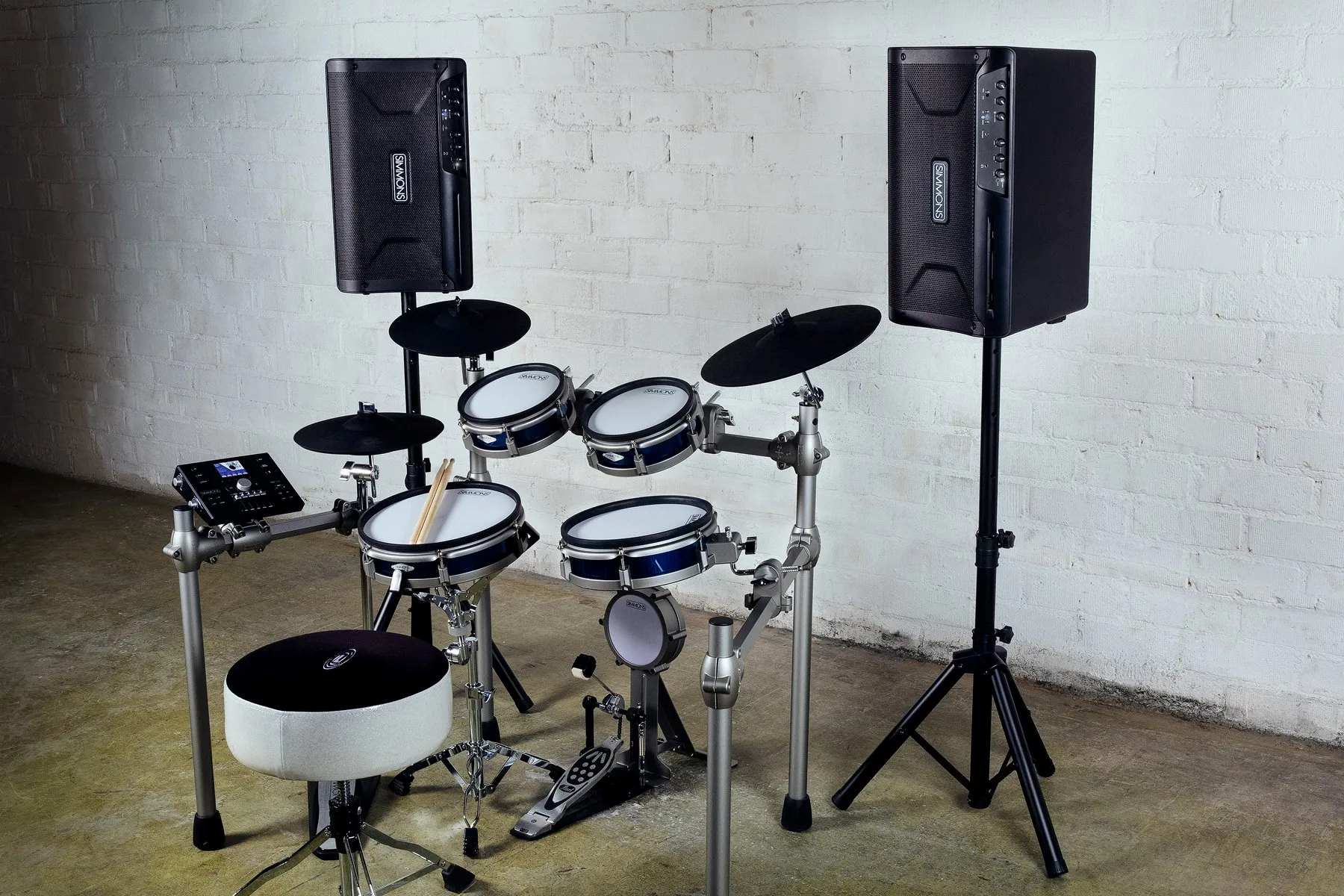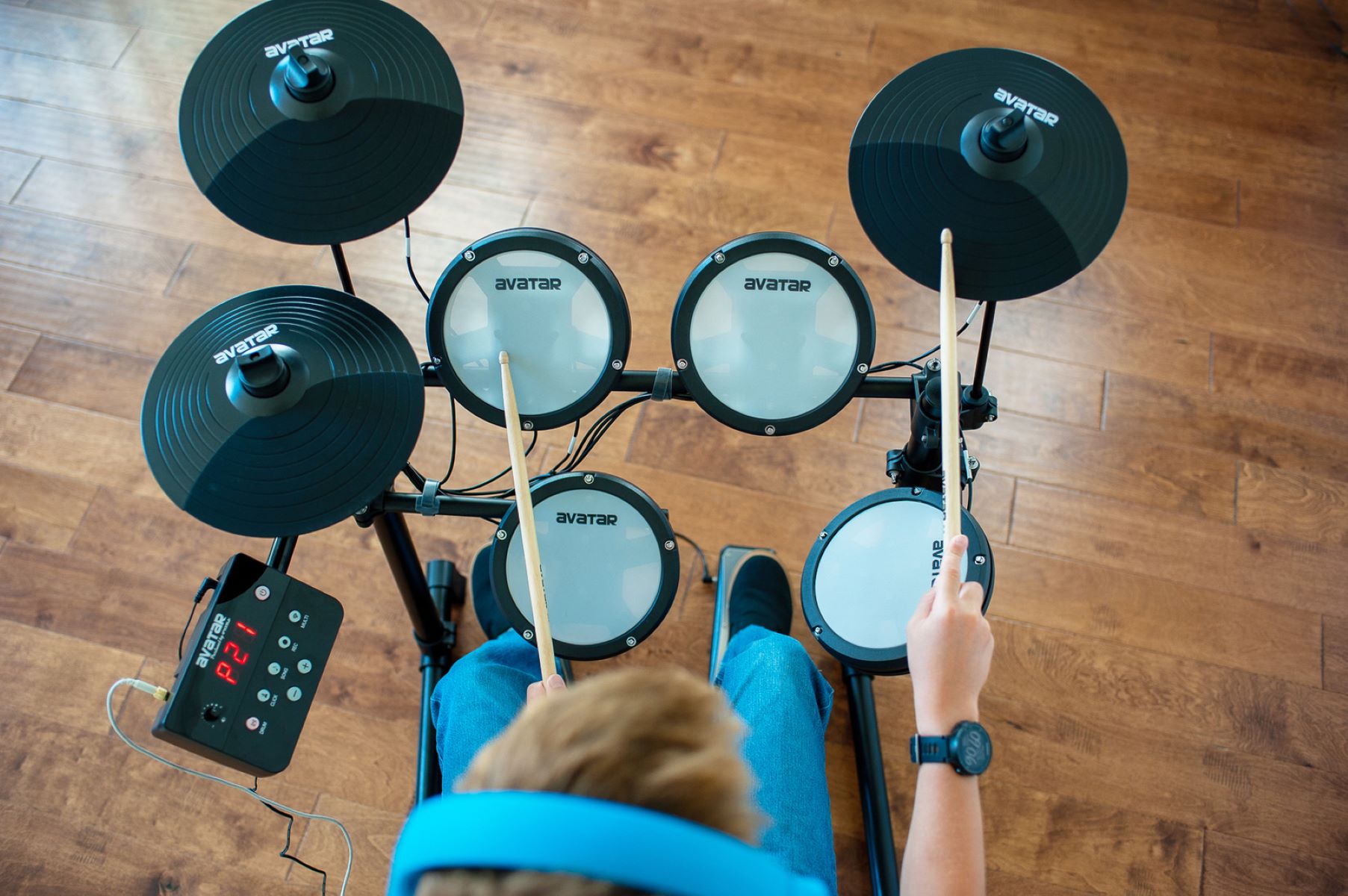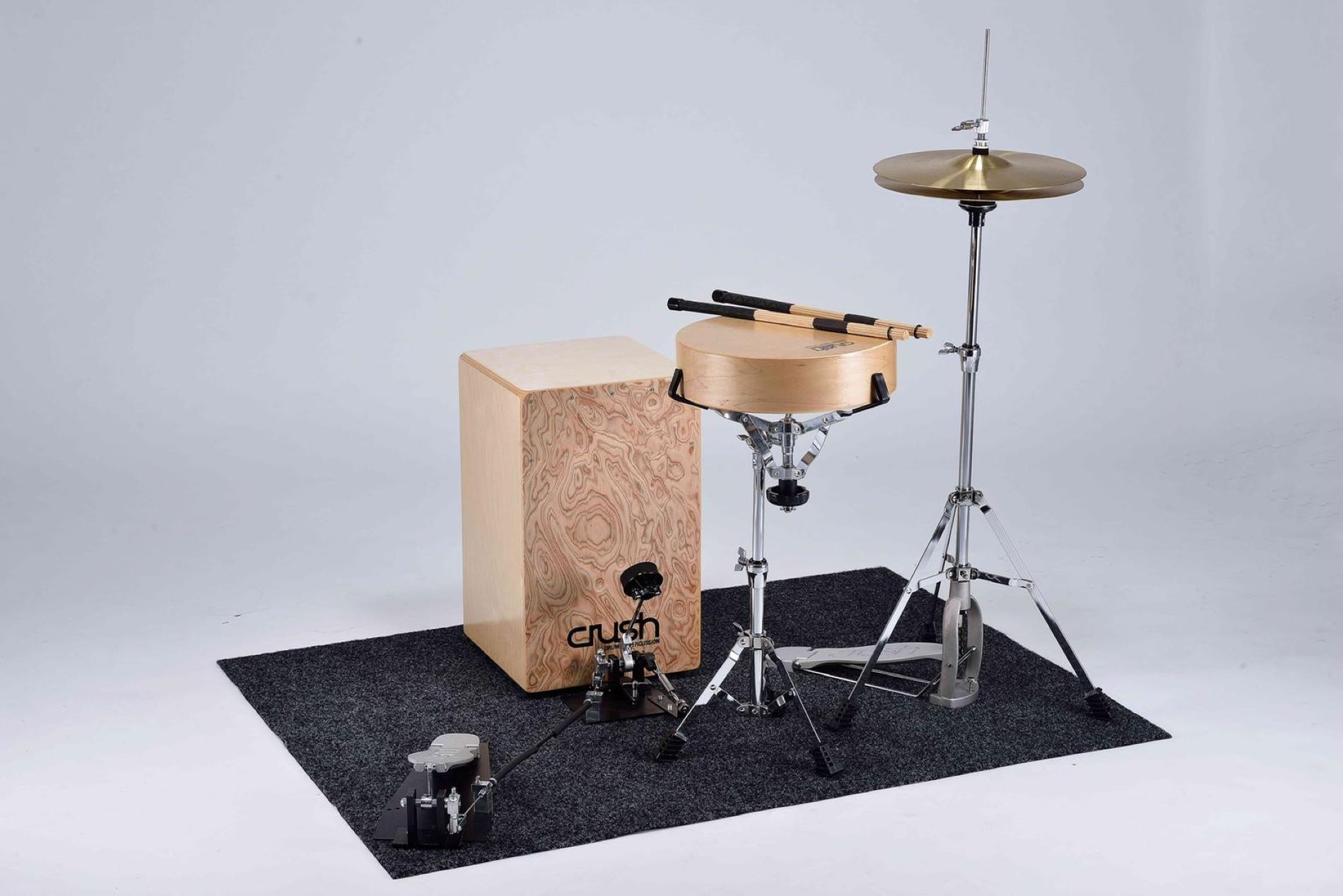Home>Instruments>Drums>How To Play The Electronic Drums


Drums
How To Play The Electronic Drums
Published: February 8, 2024
Learn how to play the electronic drums with our step-by-step guide. Discover essential techniques and tips for mastering the drums. Start your drumming journey today!
(Many of the links in this article redirect to a specific reviewed product. Your purchase of these products through affiliate links helps to generate commission for AudioLover.com, at no extra cost. Learn more)
Table of Contents
Introduction
Welcome to the exciting world of electronic drums! Whether you're a seasoned acoustic drummer looking to expand your sonic horizons or a complete beginner eager to dive into the realm of percussion, electronic drums offer a versatile and innovative way to create music. In this comprehensive guide, we will explore everything you need to know to start playing the electronic drums with confidence and skill.
Electronic drum kits have come a long way since their inception, evolving into sophisticated instruments that cater to the needs of drummers across various genres. Unlike traditional acoustic drums, electronic drum kits utilize electronic sound modules to produce a wide range of sounds, from classic drum tones to experimental textures and effects. This flexibility makes electronic drums a popular choice for recording, live performances, practice sessions, and home studios.
In this guide, we'll cover the fundamental aspects of electronic drumming, including understanding the components of an electronic drum kit, setting up the kit for optimal performance, mastering basic and advanced drumming techniques, leveraging electronic drum modules and software, and honing your skills to become a proficient electronic drummer. Whether you're drawn to the rhythmic precision of electronic music, the dynamic possibilities of hybrid drumming, or the convenience of practicing with headphones, electronic drums offer a wealth of opportunities for creative expression and musical exploration.
As we embark on this journey into the realm of electronic drums, prepare to unleash your rhythmic potential, experiment with diverse sounds, and elevate your drumming prowess to new heights. Whether you're a solo performer, a collaborative musician, or a producer seeking innovative rhythmic textures, electronic drums are poised to empower you with their boundless sonic capabilities. Get ready to experience the fusion of tradition and technology as we delve into the art of playing the electronic drums.
Understanding the Electronic Drum Kit
Before delving into the world of electronic drumming, it’s essential to grasp the fundamental components and functionality of an electronic drum kit. Unlike acoustic drums, electronic drum kits rely on electronic pads or triggers to generate sound, offering a diverse array of features and capabilities.
At the core of an electronic drum kit are the electronic drum pads, which serve as the primary interface for producing sounds. These pads are equipped with sensors that detect the impact of drumsticks or hands, translating the physical strikes into electronic signals that trigger corresponding sounds. The pads are designed to emulate the feel and response of acoustic drum heads, providing a familiar playing experience for drummers transitioning to electronic setups.
Electronic drum kits also incorporate a sound module or drum brain, which functions as the central processing unit responsible for generating and manipulating sounds. The sound module contains a library of sampled drum sounds, encompassing various drum and percussion instruments, as well as electronic effects and soundscapes. Additionally, advanced sound modules offer extensive customization options, allowing drummers to adjust parameters such as pitch, reverb, and EQ to tailor the sounds to their preferences.
Another integral component of electronic drum kits is the hardware framework, comprising the rack system, mounting clamps, and cabling infrastructure. The rack provides a stable and ergonomic setup for positioning the electronic pads, cymbal triggers, and other accessories, facilitating an efficient and comfortable playing experience. Furthermore, the cabling system enables seamless connectivity between the electronic pads and the sound module, ensuring reliable signal transmission and minimal latency.
One of the defining features of electronic drum kits is their versatility in terms of sound production and integration with external devices. Many electronic drum modules offer MIDI connectivity, enabling drummers to control external MIDI-compatible instruments and software, expanding the sonic possibilities beyond traditional drum sounds. Additionally, some electronic drum kits incorporate USB connectivity, allowing direct interfacing with computers and mobile devices for recording, performance, and music production purposes.
By understanding the architecture and capabilities of electronic drum kits, drummers can harness the full potential of these innovative instruments, unlocking a world of sonic exploration and creative expression. With a solid grasp of the electronic drum kit’s components and functionality, you’re primed to embark on a fulfilling journey into the realm of electronic drumming.
Setting Up the Electronic Drum Kit
Setting up an electronic drum kit involves a series of essential steps to ensure optimal performance, comfort, and functionality. Whether you’re assembling a compact practice kit for home use or configuring a comprehensive setup for live performances and studio recording, proper setup is crucial for maximizing the potential of your electronic drums.
The first step in setting up an electronic drum kit is arranging the hardware components, including the rack system, mounting clamps, and support arms. The rack serves as the framework for positioning the electronic pads, cymbal triggers, and other accessories in a configuration that suits your playing style and ergonomic preferences. It’s important to adjust the rack’s height, angle, and positioning to facilitate comfortable reach and efficient playability across the entire kit.
Once the rack system is in place, the next step is mounting the electronic drum pads and cymbal triggers onto the rack using the designated clamps and support arms. Careful positioning of the pads is essential to ensure optimal triggering response and ergonomic accessibility. Additionally, adjusting the tension and angle of the pads can enhance the playing feel and responsiveness, allowing for a more natural and expressive drumming experience.
After securing the electronic pads, the cabling infrastructure comes into play, facilitating the connection between the pads and the sound module. It’s imperative to route the cables in a tidy and organized manner, minimizing tangling and potential interference while ensuring reliable signal transmission. Utilizing cable management accessories such as clips and ties can help maintain a neat and efficient cabling setup.
Once the physical setup is complete, attention turns to the electronic drum module or sound brain. This pivotal component requires careful placement within the drum kit setup, considering factors such as accessibility, visibility of the display, and ease of parameter adjustment during performances and practice sessions. Additionally, ensuring adequate ventilation and protection from physical impact is crucial for preserving the longevity and functionality of the sound module.
As part of the setup process, configuring the sound module’s settings and sound library to align with your preferred drum kit configuration and performance requirements is essential. This involves assigning specific sounds to each electronic pad, adjusting trigger sensitivity, and customizing parameters such as reverb, EQ, and dynamics to achieve the desired sonic characteristics and playability.
By meticulously setting up your electronic drum kit, you can create an environment that fosters seamless playability, sonic versatility, and ergonomic comfort, empowering you to unleash your rhythmic creativity and musical expression with confidence and ease.
Basic Drumming Techniques
Mastering fundamental drumming techniques is essential for developing a strong foundation in electronic drumming. Whether you’re a beginner venturing into the world of percussion or an experienced drummer transitioning to electronic drums, honing basic techniques is key to unlocking the expressive potential of the instrument.
1. Hand Positioning: Proper hand positioning is crucial for achieving optimal control and dexterity while playing electronic drums. Whether using drumsticks or engaging in hand percussion techniques, maintaining a relaxed grip and positioning the hands in the center of the drum pads enables fluid and precise movement, contributing to enhanced playing comfort and accuracy.
2. Dynamic Control: Electronic drum pads are sensitive to varying degrees of striking force, allowing for dynamic expression through nuanced playing. Practicing control over the intensity of strikes, from gentle taps to powerful accents, enhances the musicality and emotive quality of your drumming, enriching the overall sonic texture and rhythmic impact.
3. Rudiments: Incorporating rudiments, such as single strokes, double strokes, paradiddles, and flams, into your electronic drumming practice fosters technical proficiency and rhythmic versatility. These foundational patterns serve as building blocks for more complex rhythms and embellishments, nurturing agility and coordination across the drum kit.
4. Independence Exercises: Developing independence between the limbs is a fundamental aspect of drumming proficiency. Practicing exercises that involve playing different rhythms and patterns with each hand and foot enhances coordination and limb autonomy, enabling fluid and diverse rhythmic expression on the electronic drum kit.
5. Metronome Practice: Cultivating a strong sense of timing and rhythm is essential for cohesive and precise drumming. Utilizing a metronome during practice sessions helps refine your internal timing, fosters consistency in tempo, and facilitates synchronization with other musicians, enhancing your overall musical performance and ensemble playing.
6. Listening and Mimicking: Actively listening to a diverse range of music and rhythmically mimicking patterns and grooves played by professional drummers can broaden your rhythmic vocabulary and inspire creative exploration. Emulating various styles and genres nurtures adaptability and versatility, enriching your musical repertoire and expressive capabilities.
By embracing and refining these basic drumming techniques, you lay the groundwork for a fulfilling and dynamic journey in electronic drumming. These foundational skills empower you to navigate diverse musical contexts, express your rhythmic identity, and continually evolve as a versatile and proficient drummer.
Advanced Drumming Techniques
As you progress in your electronic drumming journey, delving into advanced techniques can elevate your rhythmic prowess and expand your expressive capabilities. These techniques encompass nuanced approaches to rhythm, dynamics, and articulation, enabling you to craft intricate and compelling drum performances across diverse musical styles and contexts.
1. Ghost Notes and Subtle Articulation: Incorporating ghost notes, which are quiet and subtle drum strokes, into your playing adds depth and texture to your grooves. Mastering the art of infusing ghost notes within rhythms enhances the dynamic range and groove complexity, contributing to a more nuanced and compelling rhythmic foundation.
2. Polyrhythms and Metric Modulations: Exploring polyrhythmic patterns and metric modulations introduces layers of rhythmic complexity and sophistication to your drumming. By juxtaposing and interweaving different rhythmic meters and patterns, you can create captivating and intricate rhythmic tapestries that captivate listeners and elevate the musical landscape.
3. Linear Drumming Concepts: Embracing linear drumming, where no two limbs strike simultaneously, expands your rhythmic vocabulary and fosters intricate coordination. Implementing linear patterns across the drum kit cultivates a sense of fluidity and unpredictability, infusing your drum performances with a compelling and dynamic rhythmic character.
4. Extended Techniques and Sound Manipulation: Leveraging the capabilities of electronic drum modules and software, you can explore extended drumming techniques such as triggering samples, manipulating sound parameters in real-time, and integrating electronic effects into your performances. This approach opens doors to innovative sonic textures and expressive possibilities, enabling you to push the boundaries of traditional drumming conventions.
5. Metric Modulation: Delving into the realm of metric modulation involves seamlessly transitioning between different rhythmic subdivisions and tempos within a musical passage. Mastering this advanced technique empowers you to navigate complex rhythmic structures with precision and fluidity, adding a layer of sophistication and intrigue to your drum performances.
6. Odd Time Signatures and Unconventional Rhythms: Embracing odd time signatures, asymmetric meters, and unconventional rhythmic phrasing challenges traditional rhythmic conventions, fostering creativity and innovation in your drumming. Exploring these non-standard rhythmic frameworks expands your rhythmic palette and encourages musical exploration beyond conventional boundaries.
By integrating these advanced drumming techniques into your practice regimen and creative endeavors, you embark on a journey of continual growth and artistic evolution. These techniques empower you to craft compelling and innovative drum performances, enriching your musical contributions and leaving a lasting impact on listeners and fellow musicians.
Using Electronic Drum Modules and Software
Electronic drum modules and software play a pivotal role in shaping the sonic landscape and creative potential of electronic drumming. These versatile tools offer a myriad of features and functionalities that empower drummers to customize their sound palette, integrate electronic effects, and expand the expressive capabilities of their performances.
1. Sound Customization: Electronic drum modules house extensive libraries of sampled drum sounds, encompassing a wide range of acoustic and electronic instruments. Drummers can customize their drum kit configurations, assign specific sounds to individual pads, and adjust parameters such as pitch, decay, and tone to tailor the sonic characteristics to their preferences. This level of sound customization allows for personalized and versatile drum kit setups that cater to diverse musical genres and performance contexts.
2. MIDI Integration: Many electronic drum modules feature MIDI connectivity, enabling seamless integration with external MIDI-compatible instruments and software. This functionality opens doors to controlling virtual instruments, triggering samples, and interfacing with digital audio workstations (DAWs), expanding the sonic possibilities and creative potential of electronic drumming beyond traditional drum sounds.
3. Real-time Sound Manipulation: Advanced electronic drum modules offer real-time sound manipulation capabilities, allowing drummers to apply effects such as reverb, delay, and modulation to their drum sounds during performances. This dynamic feature enhances the expressiveness and sonic depth of electronic drum performances, enabling drummers to sculpt their sounds in response to musical dynamics and artistic intent.
4. Sample Triggering and Layering: Electronic drum modules facilitate sample triggering and layering, empowering drummers to incorporate additional sounds, such as percussion samples, sound effects, or melodic elements, into their performances. This versatility expands the sonic palette of electronic drumming, fostering creativity and innovation in rhythm creation and musical expression.
5. Performance Recording and Playback: Some electronic drum modules offer built-in recording functionality, allowing drummers to capture their performances directly within the module. This feature is invaluable for practice sessions, songwriting, and performance analysis, enabling drummers to review and refine their playing with ease. Additionally, playback capabilities facilitate the integration of backing tracks and click tracks, enhancing the overall musical experience and ensemble synchronization.
6. Software Integration and Expansion: Beyond the built-in features of electronic drum modules, drummers can leverage software applications and plugins to expand their sonic palette and performance capabilities. Utilizing drum software allows for in-depth sound editing, virtual instrument integration, and seamless synchronization with music production workflows, enriching the creative potential and versatility of electronic drumming.
By harnessing the capabilities of electronic drum modules and software, drummers can embark on a sonic exploration that transcends traditional drumming boundaries, embracing innovation, versatility, and artistic expression in their electronic drum performances.
Tips for Improving Your Electronic Drumming Skills
Enhancing your proficiency and artistry in electronic drumming involves a combination of focused practice, musical exploration, and creative experimentation. Whether you’re aiming to refine your technique, expand your rhythmic vocabulary, or elevate your expressive capabilities, the following tips offer valuable guidance for advancing your electronic drumming skills.
1. Structured Practice Regimen: Establish a structured practice routine that encompasses fundamental exercises, rudimental studies, and repertoire exploration. Dedicate focused time to refining specific techniques, building coordination, and exploring diverse musical styles, fostering a well-rounded and disciplined approach to skill development.
2. Dynamic Playing Dynamics: Embrace dynamic playing by exploring a wide range of striking intensities and articulations. Practice transitioning seamlessly between soft, medium, and loud strokes, infusing your playing with expressive nuances and rhythmic depth. Dynamic control enhances musicality and adds emotive character to your drum performances.
3. Genre Versatility: Explore diverse musical genres and styles to expand your rhythmic vocabulary and adaptability. Experiment with various genres such as rock, jazz, funk, electronic, and world music, immersing yourself in the distinct rhythmic nuances and stylistic elements of each genre to broaden your musical horizons and artistic versatility.
4. Collaborative Playing: Engage in collaborative music-making experiences by jamming with other musicians, participating in ensemble performances, or collaborating on recording projects. Collaborative playing fosters musical communication, ensemble cohesion, and adaptability, nurturing your ability to synchronize and interact with fellow musicians in diverse musical contexts.
5. Recording and Self-Evaluation: Utilize recording technology to capture and review your drumming performances. Listening back to your recordings allows for critical self-evaluation, enabling you to identify areas for improvement, assess your rhythmic precision, and refine your musical interpretations. Recording also facilitates the documentation of creative ideas and musical sketches for future development.
6. Continuous Learning: Embrace a mindset of continual learning and musical curiosity by seeking out educational resources, attending workshops, and studying the performances of renowned drummers. Engage in ongoing exploration of new techniques, musical concepts, and technological advancements in electronic drumming to fuel your artistic growth and inspiration.
7. Performance Confidence: Cultivate confidence in your performance abilities by practicing stage presence, developing stagecraft, and honing your ability to engage and connect with audiences. Building confidence enhances your comfort and assertiveness during live performances, elevating the impact and memorability of your drumming presentations.
8. Experimentation with Sound: Embrace experimentation with sound manipulation, effects processing, and electronic drum features to discover new sonic possibilities. Explore unconventional sound textures, create custom drum kit configurations, and experiment with electronic effects to push the boundaries of traditional drumming and expand your sonic palette.
By integrating these tips into your practice routine and creative endeavors, you embark on a journey of continual growth and artistic evolution, elevating your electronic drumming skills and musical contributions to new heights.
Conclusion
Congratulations on embarking on a comprehensive exploration of electronic drumming! Throughout this guide, we’ve delved into the essential aspects of electronic drumming, from understanding the components of electronic drum kits to honing fundamental and advanced drumming techniques, leveraging electronic drum modules and software, and embracing strategies for continual skill improvement. As you immerse yourself in the realm of electronic drums, remember that the journey of musical growth and artistic expression is an ongoing and enriching experience.
Electronic drumming offers a dynamic and innovative platform for drummers to unleash their rhythmic creativity, experiment with diverse sounds, and expand their musical horizons. Whether you’re drawn to the precision of electronic music, the expressive potential of hybrid drumming, or the convenience of practicing with headphones, electronic drums provide a wealth of opportunities for creative exploration and sonic versatility.
As you refine your electronic drumming skills, remember to approach your practice sessions with diligence, curiosity, and a spirit of musical adventure. Embrace structured practice regimens, dynamic playing dynamics, and collaborative experiences to foster a well-rounded and adaptable approach to drumming. Continual learning, genre versatility, and experimentation with sound manipulation are key elements in expanding your rhythmic vocabulary and expressive capabilities.
Furthermore, the integration of electronic drum modules and software opens doors to a world of sonic customization, real-time sound manipulation, and creative expansion. Leveraging these tools empowers you to sculpt your sonic identity, integrate electronic effects, and explore innovative rhythmic textures, propelling your electronic drum performances to new artistic heights.
As you navigate the realms of electronic drumming, remember that confidence, creativity, and a spirit of exploration are your allies in the pursuit of musical excellence. Embrace the challenges, celebrate the breakthroughs, and continually seek inspiration from diverse sources to fuel your rhythmic journey. Whether you’re practicing in the comfort of your home, collaborating with fellow musicians, or captivating audiences on stage, your dedication and passion for electronic drumming will shine through in your performances.
With each beat, each rhythm, and each sonic exploration, you contribute to the vibrant tapestry of electronic drumming, leaving an indelible mark on the world of rhythm and music. Embrace the evolution, celebrate your progress, and revel in the boundless possibilities that electronic drumming offers. Your rhythmic journey awaits, filled with creativity, innovation, and the transformative power of electronic drums.











